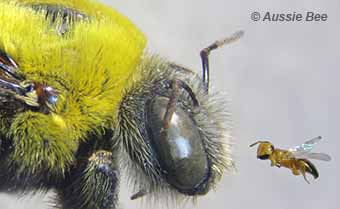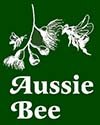FLY PHOTO GALLERY
Aussie Bee > Native Bee Identification Guide > Bee, Wasp or Fly? > Fly Photos and Identification
Many adult flies feed on nectar from flowers and some also feed on pollen. So flies (as well as wasps) are common flower visitors that bee-watchers will see in their garden.
Flies can be helpful insects in a garden because they feed on insects such as aphids and caterpillars. They can also be useful pollinators. In fact, flies are the major pollinators for some crop and wildflower species.
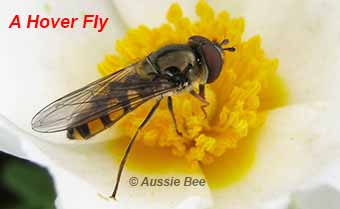
Above: Australian native flies are common flower visitors and can be useful pollinators.
The CSIRO says that there are an estimated 30,000 species of flies in Australia but only 6,400 species have been described so far.
Our Australian flies are a huge group of insects that live in a massive range of environments and feed on all kinds of diets. However, here we are mainly interested in the flies that commonly visit flowers and which might be mistaken for native bees.
There are nearly 100 families of flies, but the flies tha you will see on flowers are mostly the Flower Flies (Family Syrphidae) and the Bee Flies (Family Bombyliidae). The following discussion focuses on flies from these two families.
Spot the Differences in their Bodies!
The most important difference between flies and bees is that flies have two wings while bees have four wings. In flies, the hind wings are replaced with two tiny club-shaped structures called halteres. These act like gyroscopes and help flies to make acrobatic movements when they fly.
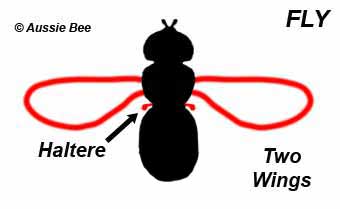
In flies, the hind wings are replaced by small drumstick-shaped structures called Halteres. In contrast, bees have four wings.
Typical flies usually also have larger eyes and shorter antennae than bees do.
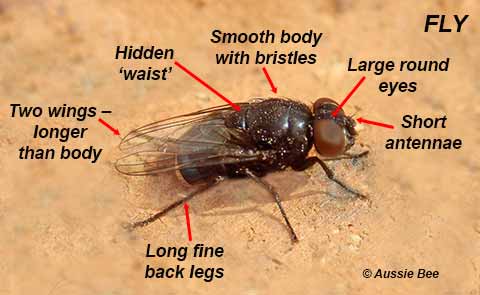
Take a look at our gallery of fly photos below, and read Aussie Bee's special report about how to distinguish flies from native bees.
FLY PHOTO GALLERY
The Flower Flies, also known as Hoverflies and Drone Flies (Family Syrphidae) and the Bee Flies (Family Bombyliidae) have many species that are common flower visitors:
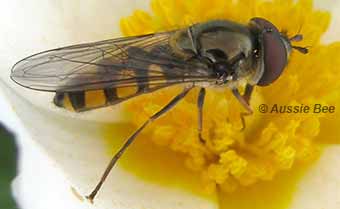
Above: this Hoverfly (Family Syrphidae) is often mistaken for a native bee because it sips nectar from flowers and its black and yellow bands look like those of a bee. Its remarkable ability to hover in mid air and its very short antennae help distinguish it from a bee. Hover flies can be useful flower pollinators and they also can help control aphids in gardens.
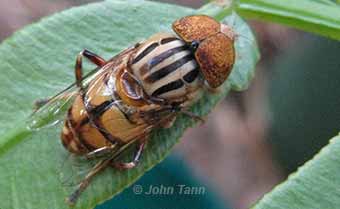
Above: this native Drone Fly, Eristalinus, (Family Syrphidae) makes a droning sound like a bee. It hovers near the flowers where it feeds. Its large eyes have an unusual spotted colouring. (Photo derived from work by John Tann, CC By 2.0).
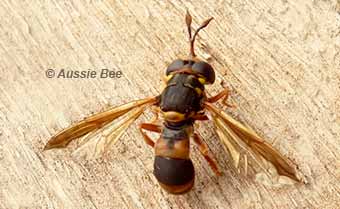
Above: This Ceriana Syrphid Fly (Family Syrphidae), with its yellow and black bands, is a wasp mimic. This species is a pest of stingless bee hives because it tries to lay eggs in the honey stores of the nest. If the colony is weak the grubs of this fly can cause serious damage to the nest structures. This species can be easily recognised by its unusual forked antennae.
The following four photos by John Tann show the remarkable Bee Flies (Family Bombyliidae). Beeflies feed on flowers and can be important pollinators. They are noticeable because they hover over the flowers in short horizontal bursts. They have long thin legs and a single pair of long flat wings:
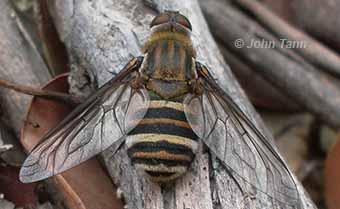
Above: this Beefly, Villa, has bold striped markings like a bee or wasp. (Photo derived from work by John Tann, CC By 2.0).
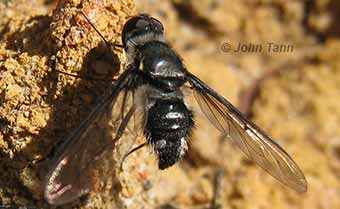
Above: this Bee Fly, Thraxan, is furry with black and white patterns. (Photo derived from work by John Tann, CC By 2.0).
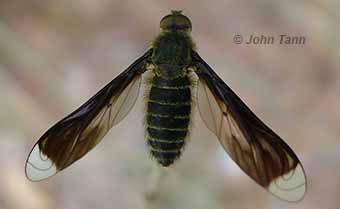
Above: another species of Bee Fly, Comptosia, with striking long wings. (Photo derived from work by John Tann, CC By 2.0).
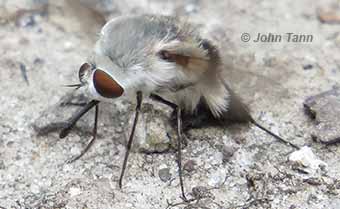
Above: this furry Bee Fly, Meomyia, was squatting on the ground and buzzing, says photographer, John Tann. (Photo derived from work by John Tann, CC By 2.0).
Species from many other Australian fly families also visit flowers. Some are nectar-feeders and some also feed on pollen. Here are some examples:
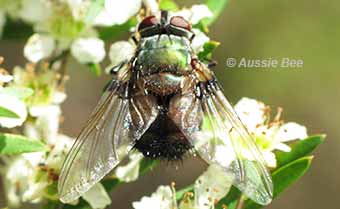
Above: a brilliantly coloured metallic-green fly on tea tree flowers.
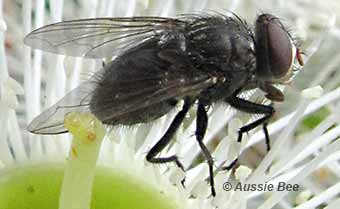
Above: a fly collecting nectar from Eucalyptus blossom.
Like to know more?
'A Field Guide to Insects in Australia' by Paul Zborowski and Ross Storey.
The Brisbane Insects website -- contains a wealth of photos and interesting information on Australian flies, wasps and bees.
Other Aussie Bee Reports on Identifying Flower Visitors:
-- Native Bee ID Guide
-- Is that a Bee, a Wasp or a Fly?
-- Native Bee Photo Gallery
-- Wasp Photo Gallery

